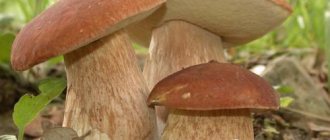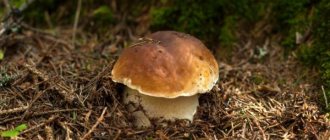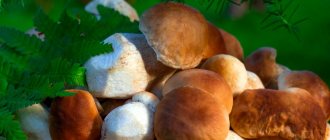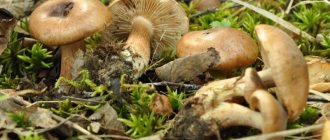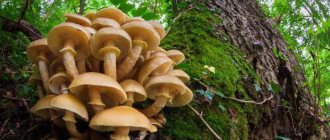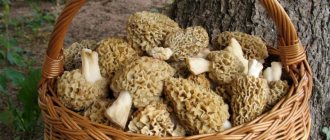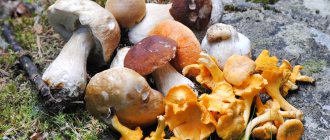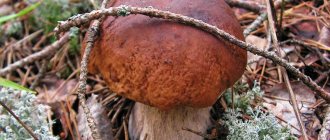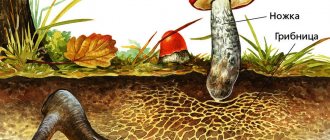Book | Video | About the project | Contacts | Sitemap | Forum | Blog | Construction | Eng
Home > Taiga articles > Edible mushrooms of Siberia and the Urals
In this article, we will look at the most popular and most beloved edible mushrooms of Siberia, the Urals, the Russian North, in general, the entire taiga belt of our country, taiga mushrooms, which we all love to hunt, because going for mushrooms is a quiet hunt, not requiring shooting.
Every autumn, crowds of people go to the taiga and collect boxes full of various edible mushrooms. Then they fry them with potatoes, cook mycelium with sour cream, dry them on the stove, marinate them for the winter and use them in other dishes. Mushrooms are a very nutritious food, however, due to some features, not all nutrients can be absorbed by our body. Mushrooms contain many essential amino acids, but many of them are not absorbed due to the presence of chitinous shells that do not dissolve in gastric juice. However, not all mushrooms are like this. And even if sometimes we don’t get as much benefit as we would like, we still can’t resist such an autumn delicacy.
In the Soviet Union, edible mushrooms were divided into 4 categories
Porcini
Porcini mushrooms are good in marinade, mushroom sauce and mushroom soup. They are famous not only for their taste, but also for their appearance. “Colonel to all mushrooms,” they say about the porcini mushroom. White has many synonyms: in different parts of Siberia and the Urals it can be called zhitnik, pechura, wood grouse, bearcrawler, cowbird, boletus, belovik, driller, cowbird. And in the Urals it has a strong and strict name - white.
If we talk about appearance, then the porcini mushroom cannot be confused with any other. The lower part of the cap is spongy, white in a young mushroom, slightly yellowish in a more mature one. The leg is thick, white at the break. In a word, if you see it once, you will not confuse it with any other. Be sure of this.
Cooking features
In order for an edible mushroom to turn out really tasty, it is worth using it for its intended purpose, which has already been “predetermined” for it by the centuries-old practice of our ancestors:
- For cooking, it is preferable to choose chanterelles, trumpets and moss mushrooms.
- Saffron milk caps, honey mushrooms and boletus are suitable for pickling. It is best to dry porcini mushrooms and honey mushrooms.
- But if you want to fry mushrooms, then boletus mushrooms, saffron milk caps, honey mushrooms and obabki are best suited. With this method of preparation they are most delicious and give a rich aroma.
Butter
There are several types of them. But in the taiga forests of Siberia and the Urals, the main one is oiler , or, as it is also called, granular oiler . Its cap is covered on top with a yellowish-brown or brown thin but dense film, which is easily removed. But in damp weather, the film on the cap becomes sticky and slimy. In young fungi, the edges of the cap are connected to the stem by a white film, which over time comes off the cap and remains on the stem in the form of a dark ring. The spongy part of the cap is tender, light yellow, the stem is short. The flesh of the oiler is cool. When you take this mushroom in your hand, it’s like a piece of fresh butter from the refrigerator.
Poisonous
Expert opinion
Melnikov Vladimir Mikhailovich
Knows 1000 ways to cook, pickle and marinate any types of mushrooms
In the Arkhangelsk region there are many mushrooms that are dangerous to humans. Honey mushrooms, rows of mushrooms, fly agarics and a number of other species can cause serious harm to health. It is worth noting that in recent years the number of poisonous specimens in the region has been decreasing.
So, if in 2014 47 cases of mushroom poisoning were detected, then in 2015 there were only 20. According to experts, this is due to an increase in yield in the north of the region, as well as the use by the population of safer harvesting methods (drying, freezing, pickling).
However, despite this, experts continue to warn the population about the need to follow the rules for collecting and eating mushrooms. How to distinguish poisonous species from edible ones:
- If you are not sure that you know which mushroom is edible, it is better not to eat it at all.
- Species that have a strong hallucinogenic effect can be used as bait to attract dogs.
- If a mushroom contains poison, it cannot be cooked and must be completely destroyed.
- If there is an unpleasant odor, it cannot be removed after cleaning or soaking.
- The surface is wet to the touch and easy to press.
- In the case of a wormy body, it must be carefully checked.
- If the mushroom is overripe, it looks unusual and does not have a characteristic smell.
- Some species (toadstools) have a ring on the stem, so when you collect them, be sure to cut it off.
Poisonous mushrooms, as a rule, grow in the same places as edible ones, but they avoid the places where they are found. Therefore, try not to walk along the paths, but go to the forest in the first half of the day. When collecting, pay attention to their appearance.
They should look fresh and healthy. In the pale head, beautiful web and sulfur-yellow polypore, the legs often turn black when cut, or the color of the lower surface of the cap is dark brown. Poisonous mushrooms should not be confused with inedible ones, which are similar in appearance. The pallid grebe is a very poisonous species.
Inedible: stinking fly agaric and panther mushroom, satanic mushroom and gall mushroom, false violin chanterelle, brick-red false honey fungus.
Expert opinion
Gennady Sergeevich Rylov
A great expert in mycology and an avid mushroom picker. Knows everything about mushrooms, their types and places of growth
Mushroom poisoning can be acute or chronic. Acute is usually characterized by the rapid development of symptoms from the organs and systems of the body and the rapid deterioration of the general condition, vomiting and diarrhea. Such signs are more common in children. In cases of chronic poisoning, the symptoms are more extended over time, during which a gradual deterioration in well-being is noted.
Signs of damage to the nervous system, blood, and liver may appear.
The first consequences of poisoning appear 6-48 hours after eating mushrooms.
Symptoms:
- nausea, vomiting, abdominal pain;
- elevated temperature;
- convulsions;
- pain in the lower back, chest;
- dizziness, apathy, drowsiness, headaches;
- frequent urination;
- decreased blood pressure;
- tachycardia (rapid heartbeat);
- pain in the pit of the stomach, thirst, dry mouth, increased sweating, weakness;
- pallor of the skin.
If signs of poisoning appear, you must immediately rinse your stomach and call a doctor.
Ryzhik
This mushroom is rightfully classified in the first category. The cap of the saffron milk cap is reddish-red on top with a funnel-shaped depression in the center. The lower part of the cap seems to be made of orange plates. The leg is short, also orange, hollow, and looks like a ring when cut. At the break of the mushroom, orange-red juice immediately releases. You touch the orange plates, give them a little squeeze, and they immediately turn green. Rizhik, unlike other mushrooms, is incomparably fragrant.
And it did well in terms of calorie content. If we talk about the calorie content in 100 g of product, then salted saffron milk caps are superior to pickled porcini mushrooms by 67 calories, dried boletus mushrooms by 8 calories, and chicken meat by 75.7 calories. The French used to be sent bottles of salted saffron milk caps from the Urals from Russia. In Paris they were valued more than champagne. They are such saffron milk caps.
Mushroom places
Mushroom pickers know that one of the most mushroom places in the region is Kargopolye. There is the village of Ertsevo, where not only the Kargopol region, but the entire Arkhangelsk region begins. But few people know that on the site of Ertsev there used to be a large village of Kargopol.
There is a village called Pozdyshevo, whose name speaks for itself, but, like many years ago, people come here for a “quiet hunt.” Kargopol land is famous for mushrooms. Truly chic places are only here, so this area is often on the lips of mushroom pickers throughout Russia.
Here is the largest collection of Russian boletus and whites. In the north of the Arkhangelsk region there are entire thickets of redhead and boletus, and sometimes you can find chanterelles. But russula and fly mushrooms are very rare.
Expert opinion
Melnikov Vladimir Mikhailovich
Knows 1000 ways to cook, pickle and marinate any types of mushrooms
However, in these places there are mushrooms of all kinds - from noble to poisonous. And if you are lucky, you can pick up a whole bag of mushrooms, although they may be wormy. So mushroom pickers need to be careful and careful.
Flag of the Arkhangelsk region
Skripun
Or a violin . This mushroom got its name from the very squeaking noise that occurs when you rub the cap against the cap of freshly picked mushrooms. Few hunters take them into the basket; they do not want to interfere with other mushrooms. But in vain. This mushroom is not at all as bad as they think it is. The creaking goes mainly to salting. First, the mushroom must be thoroughly boiled in two waters.
Well, recognizing a violin among its relatives is as easy as shelling pears: break off a piece of the cap and immediately milky juice, white as milk, will appear in large drops. If you touch it lightly with the tip of your tongue, it will burn with bitterness.
General characteristics
This region is considered one of the most promising for the development of mushroom production. Crowds of local residents, starting in early spring, head to the taiga for a tasty harvest, which is then salted, fermented, fried and steamed sparing no effort.
Mushrooms are a storehouse of microelements and vitamins. By eating them regularly, you will be able to get rid of many diseases, stimulate the immune system and normalize cholesterol levels in the blood.
All mushrooms used have a general classification and are divided into the following categories (groups):
- Category 1: edible;
- Category 2: conditionally edible;
- Category 3: inedible;
- Category 4: poisonous.
The presence of toxins determines the degree of edibility. Not only the first group is allowed to eat. Inedible and conditionally edible varieties are also used in cooking. Before the main cooking, additional processing, soaking and cooking are carried out. Poisonous mushrooms should not be eaten. It is difficult to remove toxins at home; it is better not to risk life and health.
Edible forest mushrooms of Siberia, the Urals and other regions are divided into flavor categories:
- Category 1: the most fragrant;
- Category 2: less aromatic and average taste;
- Category 3: with weak aroma and taste.
Boletus, boletus, boletus and boletus belong to the first, most aromatic and tasty category. Its representatives are used primarily by culinary specialists, using a variety of processing methods. Even in dry form, white ones do not lose their properties and remain just as tasty.
Ryzhiki, autumn honey mushrooms and russula have average taste and aroma. They are often boiled and fried.
They take longer to cook. All kinds of spices are added to give them flavor. They are used to create pates and pickling. They are pre-soaked to remove the unpleasant bitter taste of the milky juice that is present in the pulp.
Gruzd
There are parchment mushrooms, yellow and black, but this one is dry. The cap is funnel-shaped on top, while the cap of the young mushroom is flat. The plates under the cap are frequent, the stem is dense, the same color as the cap; the pulp is brittle. Dry milk mushrooms have long been valued in Russian cuisine for their taste and aroma. One of the most popular edible mushrooms in Siberia, the Urals and the East European Plain. Next to the dry milk mushrooms lives a yellow spruce mushroom with a fringe on the cap. He, like his brother, loves the silence of the forest, so he tries to hide under the spruce and fir paws.
Collection recommendations
When picking mushrooms, you should follow simple rules:
- Do not touch old and large mushrooms - they are important distributors of spores. If you accidentally knock it down, hang the mushroom or its cap on a tree branch (this will help spread the spores with air currents).
- Mushrooms with cracks on the entire (or parts) of the surface accumulate toxins, so they should be neglected.
- You should not collect even young edible specimens near roads and highways, since they, like a sponge, can absorb all harmful substances, including salts of heavy metals.
What you need to know for a successful search
Now that we have found out where there are mushrooms in the Sverdlovsk region, let's talk about how to look for them correctly. From the practical wisdom of experienced mushroom pickers, several important points can be highlighted:
- If you climb into a spruce forest, your reward will be full buckets of saffron milk caps and buttermilk. Low forests serve as a storehouse for these mushrooms.
- Boletuses and boletuses are hiding in the grass. However, a suitable environment for their reproduction is humidity. In dry weather, do not expect to carry out mass collection of mushrooms of this species.
- You can go for honey mushrooms only after the cold nights arrive. Usually this time coincides with the beginning of the first frost. These are the conditions for honey mushroom growth that are most suitable.
- The first snowfall is the time of purple rows. Entire families of these edible and quite tasty organisms are hidden under a small snow cover.
- People who collect mushrooms warn that in some areas it is dangerous to collect them. It is better not to do this in the central parts of cities and environmentally polluted places. Such areas include Asbest, Pervouralsk, Rezh, Artemovsky and Revda. You should definitely study the map, which shows zones of chemical and environmental pollution. Most dangerous places are localized in dry groves.
Forests with high humidity
Damp forests cover a decent part of the West Siberian Lowland. This is an inaccessible area, which is not easy to get into due to urmans and swamps. And yet it should be recognized that it is the most favorable area for the growth of mushrooms due to the swamps.
If you master this area and find safe paths, you can collect a huge number of edible fruiting bodies. The wet forests of the Sverdlovsk region allow local residents to stock up on mushrooms for future use. They are collected in such areas as Alapaevsky, Garinsky, Krasnouralsky, Taborensky, Serovsky. This region is also adjacent to many parts from other nearby areas.
Boletus (Redhead)
He's a redhead, he's an idiot. Valued by mushroom pickers no less than white. Very tasty and beautiful mushrooms. White leg with black dots and a wonderful red or brown cap. It is often found in mixed parts of the Yamal taiga forest and even in the tundra. It grows in families, so if you find one mushroom, there will definitely be more nearby. Redheads are fried, boiled, dried and pickled. Boletus is rich in useful minerals, fiber and carbohydrates. Contains phosphorus, iron, potassium vitamins: A, B, C and PP. The nutritional value of boletus broth is not inferior to meat broth.
Forest-steppe
The territory covers the eastern outskirts of the Krasnoufimsky district, the western outskirts of the Nizhnesiginsky district, as well as some surrounding areas of Kamensky. This includes the following districts: Kamyshlovsky, Tugulymsky, Talitsky, Bogdanovichsky, Pyshminsky. This is a mountainous area consisting of steppes and fields, characterized by copses.
The growth of mushrooms in fields and steppes directly depends on the amount of precipitation. During the rainy season, the steppe region is rich in returns. Chanterelles, boletus and milk mushrooms seem to jump out of the ground.
T
- Thelephora Thelephora caryophyllea
- Thelephora multipartita
- Thelephora palmata
- Thelephora terrestris
Tolypocladium longisegmentatum
- Trametes pubescens
Tremella foliacea
Trichaptum biforme
Trichoglossum hirsutum
- Tricholoma apium
- Tricholomopsis decora
Trichophaea hemisphaerioides
- Tubaria confragosa
Tylopilus felleus
Row purple
- Lepista naked
- Lepista violet
- Cyanosis
- Titmouse
- Bluefoot
Purple rower (Lepista nuda) is a conditionally edible mushroom from the genus Lepista of the Rowaceae family. According to the latest data, he belongs to the Govorushka genus.
The row is purple, appearance:
- Hat. At first bright violet, later light violet; towards maturity it turns pale and turns brown-ocher; in dry weather it turns light ocher. Initially convex, later flat, smooth and bare, with a diameter of 60–150 mm. The plates are initially bright purple, later brown-ocher, red-brown, 6-10 mm wide, frequent, thin, adherent or almost free.
- Leg. Cylindrical, sometimes club-shaped, solid, 50-100 mm tall and 12-30 mm thick, the surface is bright purple, later gray-violet and grayish-whitish at maturity, longitudinally fibrous, at the base with noticeable purple pubescence and remains of leaves and conifers needles
- Pulp. Fleshy, firm and purple, becoming softer and paler to a creamy color when ripe. The taste and smell are inexpressive, but pleasant.
- Spore powder. White with a delicate pinkish tint.
- Spores are 7-9 x 4-4.5 microns, ellipsoidal, slightly rough, colorless.
Where does Ryadovka violet grow:
It grows on the soil, on litter, near piles of brushwood and straw, on fallen pine needles, in coniferous (pine, spruce) and mixed (oak, spruce) forests, as well as in gardens, on compost heaps.
L
- Laccaria Laccaria bicolor
- Laccaria laccata
Lachnellula agassizii
Lachnum nudipes
- Lactarius aquizonatus
Laetiporus sulphureus
- Leccinum albostipitatum
- Lentinellus micheneri
- Lentinus strigosus
Lenzites betulina
Leotia lubrica
- Lepiota boudieri
Lepista nuda
Leucocortinarius bulbiger
Leucopholiota lignicola
- Lichenophalia alpina
- Limacella delicata var. glioderma
Lindtneria flava
- Lycoperdon echinatum
- Lyophyllum decastes
